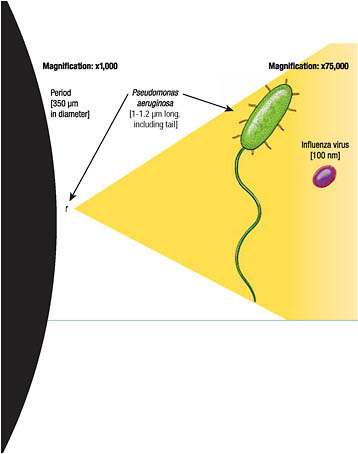
I
How Infection Works
There is a close connection between microbes and humans. Experts believe about half of all human DNA originated from viruses that infected and embedded their nucleic acid in our ancestors’ egg and sperm cells.
Microbes occupy all of our body surfaces, including the skin, gut, and mucous membranes. In fact, our bodies contain at least 10 times more bacterial cells than human ones, blurring the line between where microbes end and humans begin. Microbes in the human gastrointestinal tract alone comprise at least 10 trillion organisms, representing more than 1,000 species, which are thought to prevent the gut from being colonized by disease-causing organisms. Among their other beneficial roles, microbes synthesize vitamins, break down food into absorbable nutrients, and stimulate our immune systems.
The vast majority of microbes establish themselves as persistent “colonists,” thriving in complex communities within and on our bodies. In many cases, the microbes derive benefits without harming us; in other cases, both host and microbe benefit.

From the moment we are born, microbes begin to colonize our bodies. Each of us has a unique set of microbial communities, which are believed to play an important role in digestion and in protection from disease.
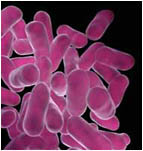
Lactobacillus bacteria, which produce lactic acid to help with digestion.
And though some microbes make us sick and even kill us, in the long run they have a shared interest in our survival. For these tiny invaders, a dead host is a dead end.
The success of microorganisms is due to their remarkable adaptability. Through natural selection, organisms that are genetically better suited to their surroundings have more offspring and transmit their desirable traits to future generations. This process operates far more efficiently in the microbial world than in people. Humans produce a new generation every 20 years or so; bacteria do it every 20 to 30 minutes, and viruses even faster. Because they reproduce so quickly, microorganisms can assemble in enormous numbers with great variety in their communities. If their environment suddenly changes, the community’s genetic variations make it more likely that some will survive. This gives microbes a huge advantage over humans when it comes to adapting for survival.
Types of Microbes
There are five major categories of infectious agents: Viruses, bacteria, fungi, protozoa, and helminths.
Viruses
Viruses are tiny, ranging in size from about 20 to 400 nanometers in diameter (see page 9). Billions can fit on the head of a pin. Some are rod shaped; others are round and 20 sided; and yet others have fanciful forms, with multisided “heads” and cylindrical “tails.”
Viruses are simply packets of nucleic acid, either DNA or RNA, surrounded by a protein shell and sometimes fatty materials called lipids. Outside a living cell, a virus is a dormant particle, lacking the raw materials for reproduction. Only when it enters a host cell does it go into action, hijacking the cell’s metabolic machinery to produce copies of itself that may burst out of infected cells or simply bud off a cell membrane. This lack of self-sufficiency means that viruses cannot be cultured in artificial media for scientific research or vaccine development; they can be grown only in living cells, fertilized eggs, tissue cultures, or bacteria.
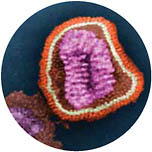
An electron micrograph of an influenza virus particle, showing details of its structure.
Viruses are responsible for a wide range of diseases, including the common cold, measles, chicken pox, genital herpes, and influenza. Many of the emerging infectious diseases, such as AIDS and SARS, are caused by viruses.
Bacteria
Bacteria are 10 to 100 times larger than viruses and are more self-sufficient. These single-celled organisms, generally visible under a low-powered
microscope, come in three shapes: spherical (coccus), rodlike (bacillus), and curved (vibrio, spirillum, or spirochete).
Most bacteria carry a single circular molecule of DNA, which encodes (or programs) the essential genes for reproduction and other cellular functions. Sometimes they carry accessory small rings of DNA, known as plasmids, that encode for specialized functions like antibiotic resistance. Unlike more complex forms of life, bacteria carry only one set of chromosomes instead of two. They reproduce by dividing into two cells, a process called binary fission. Their offspring are identical, essentially clones with the exact same genetic material. When mistakes are made during replication and a mutation occurs, it creates variety within the population that could—under the right circumstances—lead to an enhanced ability to adapt to a changing environment. Bacteria can also acquire new genetic material from other bacteria, viruses, plants, and even yeasts. This ability means they can evolve suddenly and rapidly instead of slowly adapting.
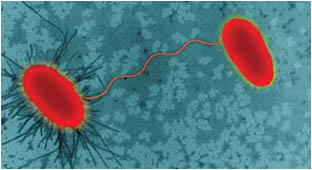
E. coli bacteria directly transferring genetic material via a pilus (the thin strand connecting the two).
Bacteria are ancient organisms. Evidence for them exists in the fossil record from more than 3 billion years ago. They have evolved many different behaviors over a wide range of habitats, learning to adhere to cells, make paralyzing poisons and other toxins, evade or suppress our bodies’ defenses, and resist drugs and the immune system’s antibodies. Bacterial infections are associated with diseases such as strep throat, tuberculosis, staph skin infections, and urinary tract and bloodstream infections.
Other Infectious Agents
The other three major types of infectious agents include fungi (spore-forming organisms that range from bread mold to ringworm to deadly histoplasmosis), protozoa (such as the agents behind malaria and dysentery), and helminths (parasitic worms like those that cause trichinosis, hookworm, and schistosomiasis).
A newly recognized class of infectious agents—the prions, or proteinaceous infectious particles—consist only of protein. Prions are thought to cause variant Creutzfeldt-Jakob disease in humans and “mad cow disease” in cattle. These proteins are abnormally folded and, when they come in contact with similar normal proteins, turn them into prions like themselves, setting off a chain reaction that eventually riddles the brain with holes. Prions evoke no immune response and resist heat, ultraviolet light, radiation, and sterilization, making them difficult to control.
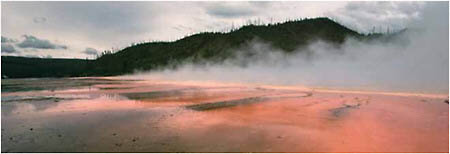
Grand Prismatic Spring, a geothermal hot spring in Yellowstone and home to microbes that have adapted to this extreme environment.
Encountering Microbes
Microbes have inhabited the earth for billions of years and may be the earliest life forms on the planet. They live in every conceivable ecological niche—soil, water, air, plants, rocks, and animals. They even live in extreme environments, such as hot springs, deep ocean thermal vents, and Antarctic ice. Indeed microbes, by sheer mass, are the earth’s most abundant life form and are highly adaptable to external forces.
New Meeting Places
Any changes that create new intersections between microbes and people pave the way for disease-causing agents to enter our species. One such change that has put us at risk is the global human population explosion—from about 1.6 billion people in 1900 to nearly 7 billion today. Humans have cleared forests for agriculture and suburbanization, leading to closer contact with environments that may harbor novel (or newly introduced) pathogens. Through much of the world’s developing tropical regions, the massive expansion of roads and human settlements has also created transition zones filled with opportunities for contact with potential disease-causing agents.
Human travel and commerce have brought other risks. Almost 2 million passengers, each a potential carrier of infection, travel daily by aircraft to international destinations. International commerce, especially in foodstuffs, adds to the global traffic

of disease-causing microbes. Because the transit times of people and goods are often shorter than the incubation periods of infection, carriers of disease can arrive at their destination before the infection they harbor is detectable. International trade and travel are associated with the emergence of such infectious agents as the SARS coronavirus and West Nile virus.
Changes in human demographics and behavior are linked with the emergence of infections such as AIDS and hepatitis C, through sexual activity and intravenous drug use. More broad-scale changes that raise the risk of infectious disease include the breakdown of public health systems, poverty, war, and famine.
Entering the Human Host
Microorganisms capable of causing disease—pathogens—usually enter our bodies through the mouth, eyes, nose, or urogenital openings, or through wounds or bites that breach the skin barrier. Organisms can spread—or be transmitted—by several routes.
Contact: Some diseases spread via direct contact with infected skin, mucous membranes, or body fluids. Diseases transmitted this way include cold sores (herpes simplex virus type 1) and sexually transmitted diseases such as AIDS. Pathogens can also be spread by indirect contact when an infected person touches a surface such as a doorknob, countertop, or faucet handle, leaving behind microbes that are then transferred to another person who touches that surface and then touches his or her eye, mouth, or nose. Droplets spread by sneezes, coughs, or simply talking can transmit disease if they come in contact with mucous membranes of the eye, mouth, or nose of another person. SARS, tuberculosis, and influenza are examples of diseases spread by airborne droplet transmission.
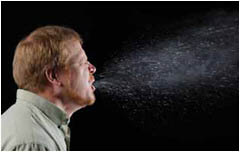
Evidence for why it is important to cover your mouth when you sneeze.
Common vehicles: Contaminated food, water, blood, or other vehicles may spread pathogens. Microorganisms like E. coli and Salmonella enter the digestive system in this manner.
Vectors: Creatures such as fleas, mites, ticks, rats, snails, and dogs—called vectors—can also transmit disease. The most common vector for human infection is the mosquito, which transmits malaria, West Nile virus, and yellow fever.
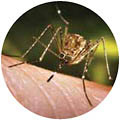
Airborne transmission: Pathogens can also spread when residue from evaporated droplets or dust particles containing microorganisms are suspended in air for long periods of time. Diseases spread by airborne transmission include measles and hantavirus pulmonary syndrome.
How Pathogens Make Us Sick
Infection does not necessarily lead to disease. Infection occurs when viruses, bacteria, or other microbes enter your body and begin to multiply. Disease, which typically happens in a small proportion of infected people, occurs when the cells in your body are damaged as a result of infection, and signs and symptoms of an illness appear.
In response to infection, your immune system springs into action. White blood cells, antibodies, and other mechanisms go to work to rid your body of the foreign invader. Indeed, many of the symptoms that make a person suffer during an infection—fever, malaise, headache, rash—result from the activities of the immune system trying to eliminate the infection from the body.
Pathogenic microbes challenge the immune system in many ways. Viruses make us sick by killing cells or disrupting cell function. Our bodies often respond with fever (heat inactivates many viruses), the secretion of a chemical called interferon (which blocks viruses from reproducing), or by marshaling the immune system’s antibodies and other cells to target the invader. Many bacteria make us sick the same way, but they also have other strategies at their disposal. Sometimes bacteria multiply so rapidly they
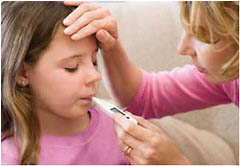
A fever is often part of the immune system’s response to infection.
crowd out host tissues and disrupt normal function. Sometimes they kill cells and tissues outright. Sometimes they make toxins that can paralyze, destroy cells’ metabolic machinery, or precipitate a massive immune reaction that is itself toxic.
Other classes of microbes attack the body in different ways:
-
Trichinella spiralis, the helminth that causes trichinosis, enters the body encased in cysts residing in undercooked meat. Pepsin and hydrochloric acid in our bodies help free the larvae in the cysts to enter the small intestine, where they molt, mature, and ultimately produce more larvae that pass through the intestine and into the bloodstream. At that point they are free to reach various organs. Those that reach skeletal muscle cells can survive and form new cysts, thus completing their life cycle.
-
Histoplasma capsulatum, a fungus that transmits histoplasmosis, grows in soil contaminated with bird or bat droppings. Spores of the fungus emerge from disturbed soil and, once inhaled into the lungs, germinate and transform into budding yeast cells. In its acute phase, the disease causes coughing and flu-like symptoms. Sometimes histoplasmosis affects multiple organ systems and can be fatal unless treated.
-
The protozoa that cause malaria, which are members of the genus Plasmodium, have complex life cycles. Sporozoites, a cell type that infects new hosts, develop in the salivary glands of Anopheles mosquitos. They leave the mosquito during a blood meal, enter the host’s liver, and multiply. Cells infected with sporozoites eventually burst, releasing another cell form, merozoites, into the bloodstream. These cells infect red blood cells and then rapidly reproduce, destroying the red blood cell hosts and releasing many new merozoites to do further damage. Most merozoites continue to reproduce in this way, but some differentiate into sexual forms (gametocytes) that are taken up by the female mosquito, thus completing the protozoan life cycle.
![]()
These and many other ingenious pathways to causing disease demonstrate pathogens’ rich evolutionary legacy and their continued inventiveness. In the next section, we look more closely at how some of these organisms have learned to thrive—often at humans’ expense.








